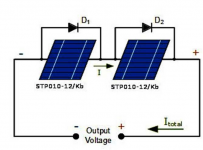Sorry to ask what is probably a simple question. Kinda new to PV systems. What I deal with is pretty simple. Like today, a single 200W panel keeping a couple 100 Ah batteries charged up. So I wire up a panel today and it has half a dozen terminals with two of them tied to the panel with another "middle terminal" between them. There are two diodes. One between the Neg and this "middle terminal" and the other between this "middle terminal" and the Pos. It was mentioned that this is so you can wire it up for 12V instead of 24V, but I dismissed the idea. Obviously the diodes would protect the panel from reverse polarity (and also indicate the polarity of the terminals - they were not marked...). But why two diodes, and why have a "middle terminal." My only guess was for a "functional ground" system? Can't wait to be educated by you fine folks.

Someone is
“barking up the wrong tree”.
Your allusion regarding the purpose of those diodes are “theoretically correct”.
I say theoretically correct because (as you mentioned) they are protection from polarity reversal.
You did not mention the voltage rating of the PV .
I’m assuming this is for a residential use 12 volts to accommodate the generic house car.
Industrial and Commercial applications are usually -- around 24, 36 and 48 volts.
The middle terminal that connects the positive and negative terminals of the diodes provides an option to the installer to ensure
congruity with the MPPT that is available on the market.
There are two types of diodes on the PV, they are:
1. The blocking diodes.
2. The bypass Diodes (these are is the ones being beaten to death.)
Generally the
bypass diodes are inherently built-in to the PV array. They are not designed to be altered or removed by installers or they are non-
serviceable by anyone outside the factory.
As mentioned by other posters, it shunts the under performing PV cell or if the sun rays being blocked. This is to ensure continued supply wihout losing power even though at a lower voltage.
On the other hand--
Blocking diodes prevent current going in reverse to cause battery discharge at night when there is no PV production .
These are what you have
They are usually mounted in the
combiner box or at a location separate from the PV ARRAY, that are accessible to installers and technicians.
I’m aware that this comment will raise
“hackles” and maybe cause an avalanche of unkind words among purported
experts –but, I say “BRING IT ON”



